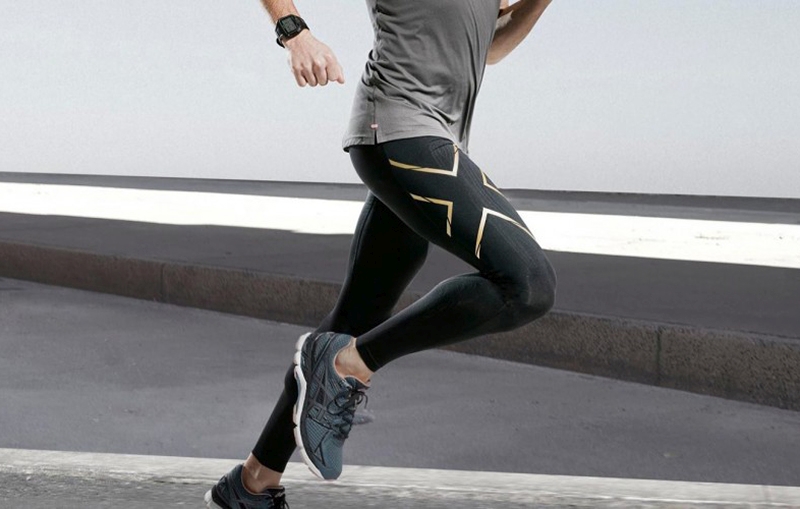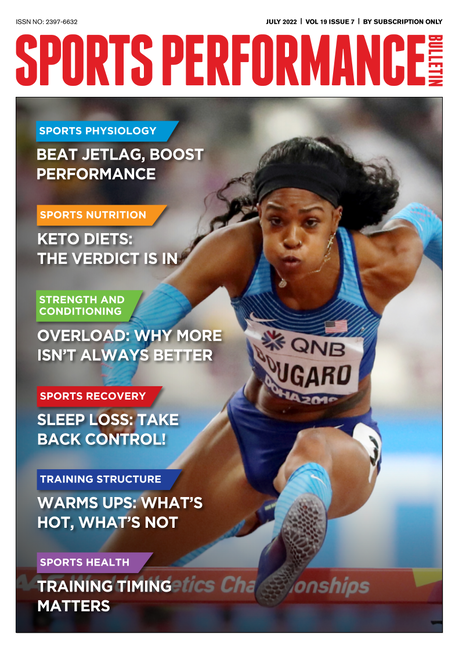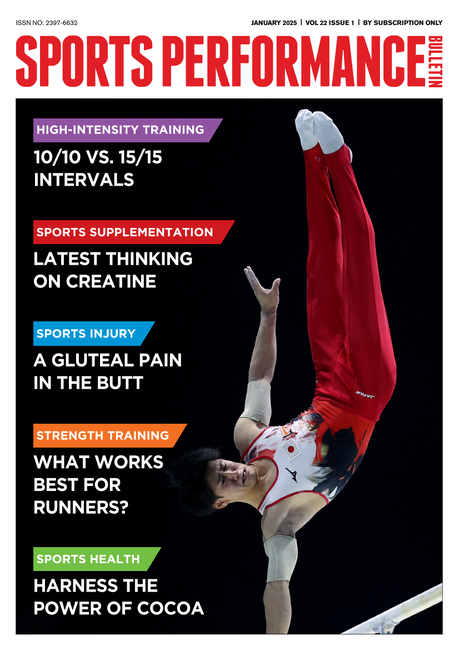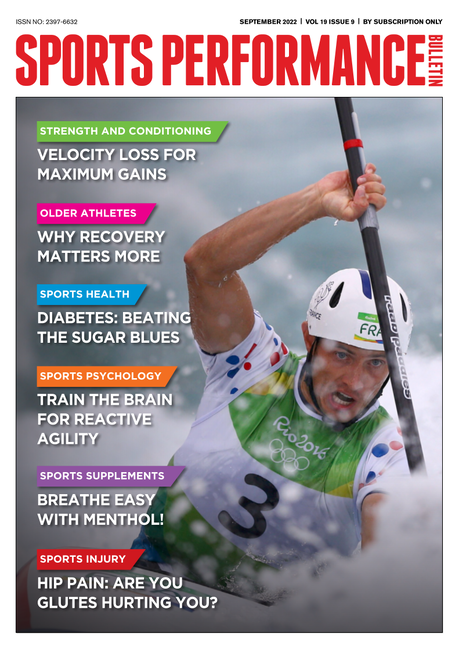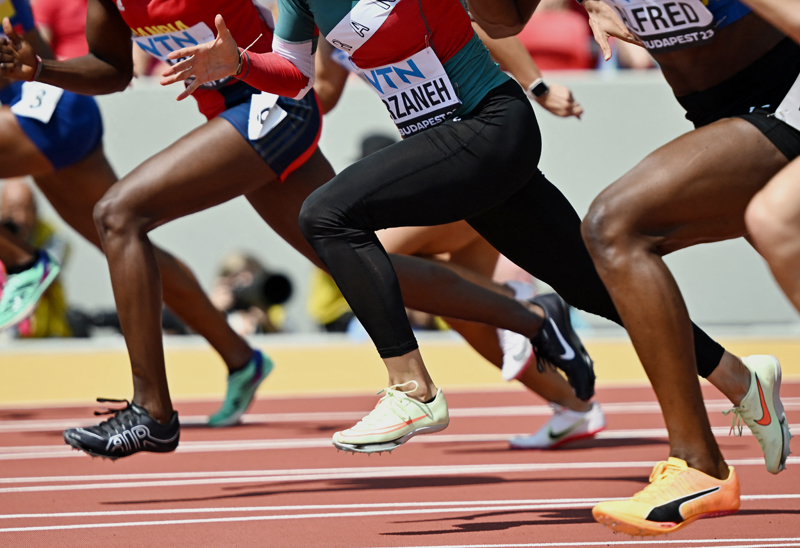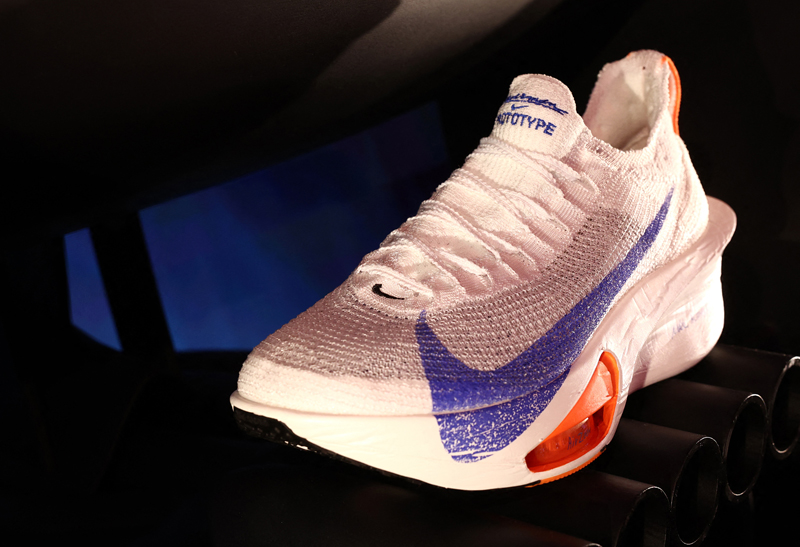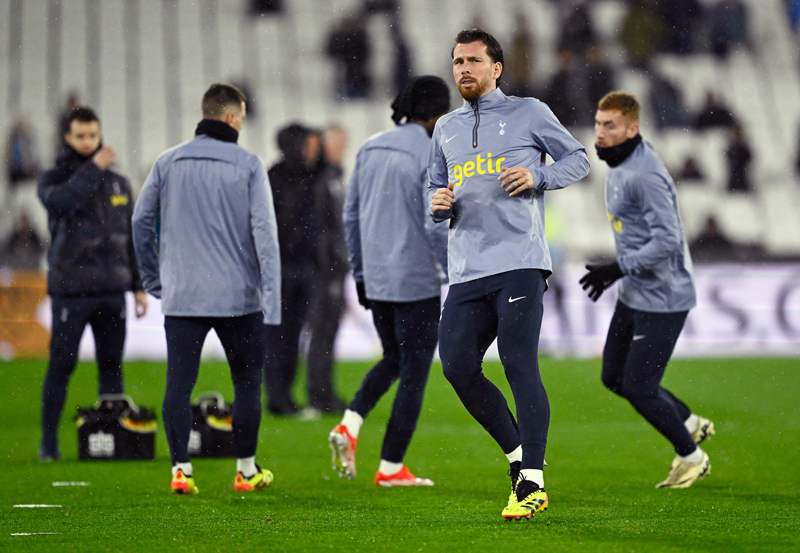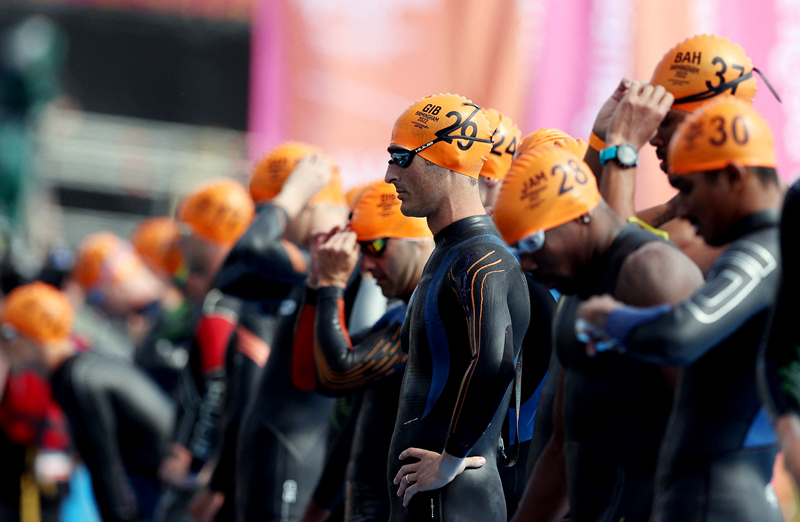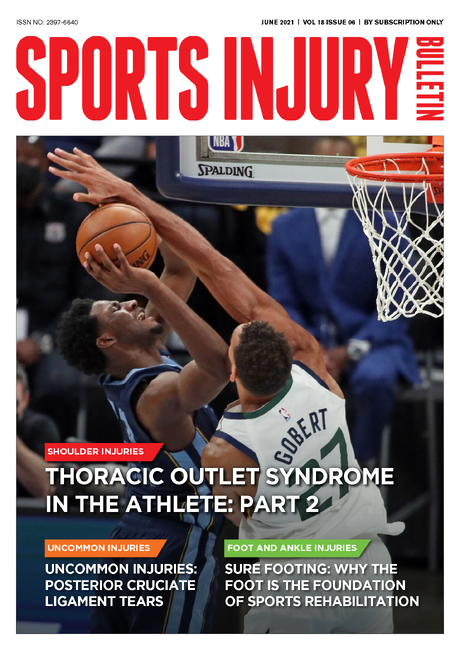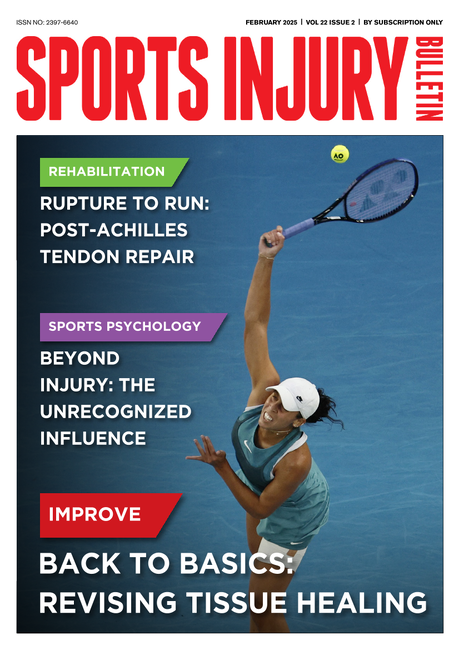The use of compression clothing such as elastic shorts, tights and vests has become increasingly widespread amongst athletes and fitness enthusiasts alike. But what scientific evidence is there for its efficacy? Andy Harrison and Kevin Thompson investigate
Initial studies on the use of compression garments focused on postoperative patients and the potential protection that compression could provide against a venous thrombosis. These studies demonstrated an increase in venous blood flow in the lower extremities. Following these findings in the clinical population, scientists began investigating the effects of compression clothing on an athletic performance, initially focusing on power-based sports.American scientists investigated the effect of compression shorts on power production during maximal effort vertical jumps(1). Varsity volleyball athletes completed 10 maximal countermovement (ie with knee bend) vertical jumps, one every three seconds as cued by an auditory signal. Although the compression shorts did not influence maximal jump power, the results demonstrated that the athletes were better able to maintain power output during the repeated efforts. The investigators suggested that using the compression shorts increased the athletes’ ability to resist fatigue.
The effect of compression shorts on explosive activities was further explored in a 2003 study(2). Varsity track athletes, specialising in sprint or jump events, were used to compare custom fit compression shorts with loose-fitting gym shorts. Significant increases in countermovement jump height plus significant reductions in muscle oscillation during landing were reported in the compression clothing group. In this same group, 60m sprint times were not affected but average hip angle was reduced. Although not measured as part of the study, this suggests that stride frequency was increased.
There are many possible mechanisms via which compression clothing may have enhanced performance in these power-based activities. There is evidence that augmented proprioception may have provided an improvement in technique, while the reported reduction in the oscillatory displacement of the muscle may have promoted enhanced neurotransmission and mechanics at the cellular and molecular level.
Compression clothing and oxygen cost
More recently, scientists have focused their attention on whether compression clothing can positively influence physiological parameters during sub-maximal activity. Researchers examined the effects of wearing compression tights on oxygen cost during sub-maximal running exercise(3). In a two-part study, six trained runners were assessed using an indoor 200m track.Firstly, aerobic energy cost was evaluated at 10, 12, 14 and 16km/h. Secondly, the increase in energy cost over time (often referred to as the ‘slow component’ – expressed as the difference in VO2 values between minute 2 and the end of exercise) was determined via the completion of a 15-minute continuous run corresponding to 80% of the subjects’ VO2max.
Results showed a significantly lower energy cost, compared with that of the control group (wearing conventional shorts), at only 12 km/h, although similar trends were noted at 10 and 14km/h. Significant reductions in VO2 slow component were also reported compared with classic elastic tights (26%) and conventional shorts (36%).
Although no consensus currently exists as to the exact causes of the VO2 slow component during prolonged exercise, several variables have been identified, including muscle oxygen availability, cardiorespiratory work and blood lactate concentration. However, recent evidence seems to point towards motor unit recruitment patterns in the aetiology of the VO2 slow component(3).
The study above aimed to evaluate the effects of wearing compression tights on some traditional ‘muscle efficiency’ indices. As with the power-based studies, the researchers concluded that the positive effect of wearing the compression clothing may arise due to an enhancement of the motion pattern by increasing proprioception and muscle coordination. However, this study also showed a reduction in the metabolic cost of running at a specific speed. A reduction in muscle oscillation (which occurs because of the repetitive impact loading during running) was speculated to have enhanced performance and the authors went on to suggest that wearing a lower-body compressive garment may reduce muscle fatigue by supporting more active muscles and applying pressure in such a way as to support muscle fibres in their contraction direction.
Compression clothing and blood lactate
The favourable effects of compression clothing on the muscle pumping action of the cardiovascular system have led scientists to speculate whether increases in venous return could assist in the removal of blood lactate from exercising muscles.In one of the first exercise-related trials, scientists tested six male college students to determine the effects of wearing compression stockings on exercise response(4). The students completed both a treadmill (VO2max test) and bicycle ergometer (3 separate 3-minute bouts at 110% of their VO2max) assessments. The results from both tests showed a decrease in post-exercise lactate concentration when the compression clothing had been worn during the exercise. The investigators concluded that the compression stockings were increasing the lactate retained in the muscles, thereby reducing the amount released into the blood.
The garments used in the above studies are commercially designed for long-term wear in sports and training. It is common practice, however, for power lifters to use tightly bound wraps around various joints of the body to enhance force production. Anecdotally, the use of ‘super-suits’ in power lifting appears to enhance high force development for 1RM lifts. Such ‘suits’ are considered extreme compression as lifters can only tolerate them for short periods. The level of compression exerted by the garments discussed in this article is much lower.
A team of American scientists investigated whether even this lower level of compression added a significant external resistance to the actions of the contracting musculature whilst exercising(5). Active subjects were asked to complete isokinetic knee extension/flexion movements (3 sets of 50 maximal efforts) and their maximal number of squats (at 70% 1RM). The primary finding from the study was that the comfortable compression levels found in the commercial garments did not have a negative effect on force production or total work capacity of the thigh muscles.
This study suggests that the use of commercially available compressive shorts does not add any significant amount of resistance to repetitive muscle actions, that would add an additional fatigue factor leading to diminished performance. In fact, other studies have reflected that any small opposing torque may reduce injury by assisting the eccentric action of the hamstrings, eg at the end of the recovery phase whilst running(2,6). Further injury prevention may be afforded by compression clothing via the reported reduction in muscle oscillation on landing from a jump(2).
In addition to the above, there is evidence to suggest that compression clothing may improve exercise performance by reducing the impact of hot and/or humid conditions on the body’s thermoregulatory system(7). It is well documented that heat strain as a result of an elevated core body temperature can cause a reduction in exercise performance. In humans, the primary means of cooling the body during exercise is through the evaporation of sweat from the skin surface. Increases in skin and core temperature and a reduction in cooling efficiency are observed when clothing interferes with the evaporation of sweat from the skin. It has been suggested that compression clothing assists the rate of evaporation by facilitating a faster transfer of sweat from the skin to the fabric. Once there, the sweat can be transported through the fabric and dispersed more quickly and evenly over a larger area allowing evaporation to be maximised. If this is the case then athletes would feel cooler during exercise and perceive the activity as being less difficult.
Compression clothing and recovery
Recent compression clothing research has focused predominantly on its possible potential to aid post-exercise recovery. A recent New Zealand study has examined the effectiveness of four interventions on the rate and magnitude of muscle damage recovery, as measured by creatine kinase (CK)(8).Monitored before, immediately after, 36 and 84 hours after competitive rugby matches, 23 elite male rugby players were randomly assigned to complete one of four post-match recovery strategies:
- Contrast water therapy (CWT – 1 minute cold followed by 2 minutes hot repeated 3 times, immersed in a bath to shoulder level);
- Compression tights (CT);
- Low-intensity active cool-down (ACD);
- Passive recovery (PR).
In another study, a group of untrained women wore a compression sleeve for five days after performing two sets of 50 arm curls using an isokinetic dynamometer, with a maximal eccentric muscle action superimposed every fourth passive repetition(9). Results demonstrated that swelling, perceived muscle soreness and any impact to elbow joint range of motion were all reduced in those subjects that had used the compression sleeve. The compression sleeve group also demonstrated an increase in the rate of force production recovery. Furthermore, the investigators noted a decrease in the magnitude of CK elevation post muscle damage in the compression group, suggesting an enhanced removal of the by-products caused by the activity bout.
The same researchers repeated the above study, but with untrained males, in order to examine if the same benefits of compression clothing were observed(10). As in the previous study, the subjects performed two sets of 50 passive arm curls, after which a compression sleeve was applied to their arm and worn for five days. Once again, the compression treatment group had a reduced amount of swelling, perceived muscle soreness and loss of elbow joint range of motion. An increase in the rate of force production recovery was also noted as was a significantly lower circulatory CK concentration post activity compared to the control group. The scientists suggested two possible reasons for this: 1) the release of these damage markers was attenuated as a result of the compression treatment; or 2) the compression aided in their clearance and removal from the injured area. This study suggests that the use of compression clothing may be a viable post-activity recovery option; the fact that this strategy is simple, requiring no equipment and/or facilities and can be completed/continued in transit makes it especially attractive.
Summary
Too often modern athletic clothing is worn simply as a fashion garment. However, for those individuals involved in intense and/or competitive activity, the literature would suggest that compression clothing may provide both a performance and a recovery aid. The mechanisms that mediate any performance gains appear to be related to a considerable number of variables including enhanced proprioception, reduced muscle oscillation, enhanced lactate removal and/or psychological factors (ie subjects like the feel of the garments and perceive that they can improve performance).It appears that there is a dynamic continuum ranging from the extreme mechanical support compression level (ie ‘super-suits’) to lower compression levels that engage other biological mechanisms. This suggests that there may be a subtle ergonomic interplay between the garment and natural biological mechanisms. Certainly it indicates that the use of different types and amounts of compression in garment construction should be a consideration and may need to be sport/purpose specific.
The researchers investigating the effects of compression clothing on explosive activities reported that the material used in their custom-fit compression garment was capable of attenuating impact forces and that this may provide some benefit if worn during contact sports(2). Future garment construction and/or areas of the body targeted may need to reflect the specific biological mechanisms and demands of the sport for which it’s intended.
Strenuous training and competition places an enormous demand on the physical and physiological reserves of athletes. Individuals vary in their ability to cope and in their tolerance of competitive stressors. The regeneration of normal metabolic reserves should be a priority and the practices to promote recovery should commence immediately post training or competition. The use of compression clothing appears to provide an economical and effective strategy that offers a practical alternative or additional recovery method. However, as with other recovery interventions, the optimal duration and combination with other methods requires further investigation.
Andy Harrison BSc, MSc is a physiologist who works as athlete services manager for the English Institute of Sport
Kevin Thompson PhD is a physiologist who works as regional manager for the English Institute of Sport
References
1. J Sport Con Res 1996; 10:180-183
2. J Sport Sci 2003; 21:601-610
3. Int J Sports Med 2006; 27:373-378
4. Am J Physical Med 1987; 66:121-132
5. J Sport Con Res 1998; 12:211-215
6. Sports Med 1997; 23:397-404
7. Eur J Appl Physiol 1998; 78:487-493
8. Br J Spts Med 2006; 40:260-263
9. J Sports Rehab 2001; 10:11-23
10. J Orthop Spts Phys Ther 2001; 31:282-290
